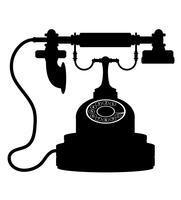A newspaper clipping from The Tacoma News Tribune, dated April 11, 1953, features an article titled “There’ll Be No Escape in Future From Telephones”.
The article quotes Mark R. Sullivan, president of the Pacific Telephone & Telegraph Co., who speculated on the future of the telephone.
Sullivan’s prophecy included the idea that individuals would carry telephones with them, similar to a watch today. He also suggested that future phones might not require a dial and users could see each other while talking.
A final speculation was that the device might even be able to translate between languages.
Not from 1950, but is at least as old as 1920.

Telephones gained popularity in the 1890s, so I’m not sure how much older this sci-fi concept of poker telephones could have even existed.
The 1920s was when Telephones were entering mainstream use, and no longer an absurdly rich persons toy. The idea of a poker telephone forcing you to work is more working-class mindset, so I find it hard to believe that the idea would come much earlier than 1920.
Note that the technology for wireless radios was popularized in the 1920s as well. Militaries used wireless / radio communications in the 1900s through WW1 but it could only be afforded by Navy and Battleships (the most expensive military equipment). WW1 Tanks used lol semaphore flags for communication !!!
As radio got more popular, the marriage of phone and radio would inevitably come up as a sci concept.
Gotta love how, 100 years ago, the common man was… Hitler? Like sure maybe he resembles Chaplin more, but still.
By 1927 AT&T had created its earliest electromechanical television-videophone called the ikonophone (from Greek: “image-sound”),[22] which operated at 18 frames per second and occupied half a room full of equipment cabinets.[23][24] An early U.S. test in 1927 had their then-Commerce Secretary Herbert Hoover address an audience in New York City from Washington, D.C.; although the audio portion was two-way, the video portion was one-way with only those in New York being able to see Hoover.
https://en.wikipedia.org/wiki/History_of_videotelephony
It’s not super surprising that video phones were predicted in the 50s, considering they are almost as old as phones themselves, conceptually, and only lag a bit behind as actual technology.
Additionally the first cellphones were available just before the 50s, so that’s not a huge stretch either.
In 1949, AT&T commercialized Mobile Telephone Service. From its start in St. Louis, Missouri, in 1946, AT&T introduced Mobile Telephone Service to one hundred towns and highway corridors by 1948. Mobile Telephone Service was a rarity with only 5,000 customers placing about 30,000 calls each week. Calls were set up manually by an operator and the user had to depress a button on the handset to speak and release the button to listen. The call subscriber equipment weighed about 80 pounds (36 kg)[15]
That’s not really a cell phone; that’s more of a walkie talkie with a phone taped to it


